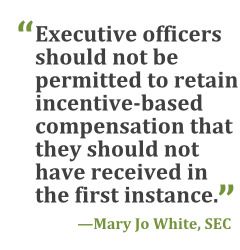U.S. companies forced to correct accounting failures would haveto reclaim a portion of bonuses awarded to corporate bosses under arule proposed Wednesday by the Securities and Exchange Commission(SEC).
|The SEC measure, passed on a 3-2 vote, would expand thecircumstances under which executives could be punished if theirfirms restate past earnings. Companies would have to claw backstock or cash bonuses based on erroneous results even if it wasn'tintentional.
| Thechange would build on rules—approved more than a decade ago inresponse to fraud at Enron Corp. and WorldCom Inc.—that permittedclawbacks only when it could be shown that books were cookedintentionally.
Thechange would build on rules—approved more than a decade ago inresponse to fraud at Enron Corp. and WorldCom Inc.—that permittedclawbacks only when it could be shown that books were cookedintentionally.
“Executive officers should not be permitted to retainincentive-based compensation that they should not have received inthe first instance,” SEC Chair Mary Jo White said in a statementbefore the vote.
|Companies restated financial results 831 times in 2014,according to an April report by Audit Analytics. About 42 percentof the restatements took a bite out of the company's bottom line,according to the report. The others didn't affect the company'searnings but required correcting balances for shareholders' equity,cash flow, or other accounts.
|Clawbacks Would Affect VPs of Finance, Sales, and ChiefAccounting Officer
|The SEC proposal also would cover a wider group than the earlierrules, which applied only to chief executive officers and chieffinancial officers. The new plan would claw back pay from anyexecutive involved in preparing erroneous figures, including afirm's top accounting officer and vice presidents in charge offunctions such as sales, administration, or finance.
|“Investors should not be left holding the bag while executivesreap benefits when reporting false financial results,” saidCommissioner Kara Stein, a Democrat who voted for the plan.
|Under the plan, companies would be required to disclose thetotal amount of pay forfeited after a restatement without namingthe executives. If an executive required to forfeit pay hasn'tgiven it back after 180 days, the company would have to disclosethe name of the person and the amount owed.
|Republican commissioners who opposed the plan said it couldcreate perverse incentives. Executives may seek higher salaries tocompensate for the risk that incentive pay could be clawed back,said Commissioner Michael Piwowar.
|“Subjecting a broad swath of executive officers to a no-faultrecovery mandate creates the potential for substantial injustice,”said Commissioner Daniel Gallagher, also a Republican.
|Companies that don't adopt clawback policies could have theirshares delisted by stock exchanges under the proposed rule, the SECsaid. More than 85 percent of companies in the S&P 500 Indexalready have clawback policies more stringent than existing SECstandards, said Carol Bowie, director of research at InstitutionalShareholder Services.
|JPMorgan Chase & Co. two years ago clawed back more thanUS$100 million in pay from managers who oversaw a $6.2 billiontrading loss. The bank said it invoked its own clawback policy intaking back pay previously granted to executives responsible forwhat came to be know as the London Whale trades.
|Michael Laphen, former chief executive officer of ComputerSciences Corp., agreed last month to return more than $3.7 millionover his role in accounting fraud that occurred in 2010 and 2011.CSC had manipulated accounting models to hide a drop in earningsafter it failed to meet deadlines for a contract with the U.K.'sNational Health Service, the SEC said. The largest restatement in2014 was KBR Inc., which was forced to reduce net income for 2013by $154 million.
|The proposal is the last major executive-compensation rule theSEC must issue under Dodd-Frank. Companies will have 60 days tocomment before the agency can take final action.
|Copyright 2018 Bloomberg. All rightsreserved. This material may not be published, broadcast, rewritten,or redistributed.
Complete your profile to continue reading and get FREE access to Treasury & Risk, part of your ALM digital membership.
Your access to unlimited Treasury & Risk content isn’t changing.
Once you are an ALM digital member, you’ll receive:
- Critical Treasury & Risk information including in-depth analysis of treasury and finance best practices, case studies with corporate innovators, informative newsletters, educational webcasts and videos, and resources from industry leaders.
- Exclusive discounts on ALM and Treasury & Risk events.
- Access to other award-winning ALM websites including PropertyCasualty360.com and Law.com.
*May exclude premium content
Already have an account? Sign In
© 2024 ALM Global, LLC, All Rights Reserved. Request academic re-use from www.copyright.com. All other uses, submit a request to [email protected]. For more information visit Asset & Logo Licensing.







